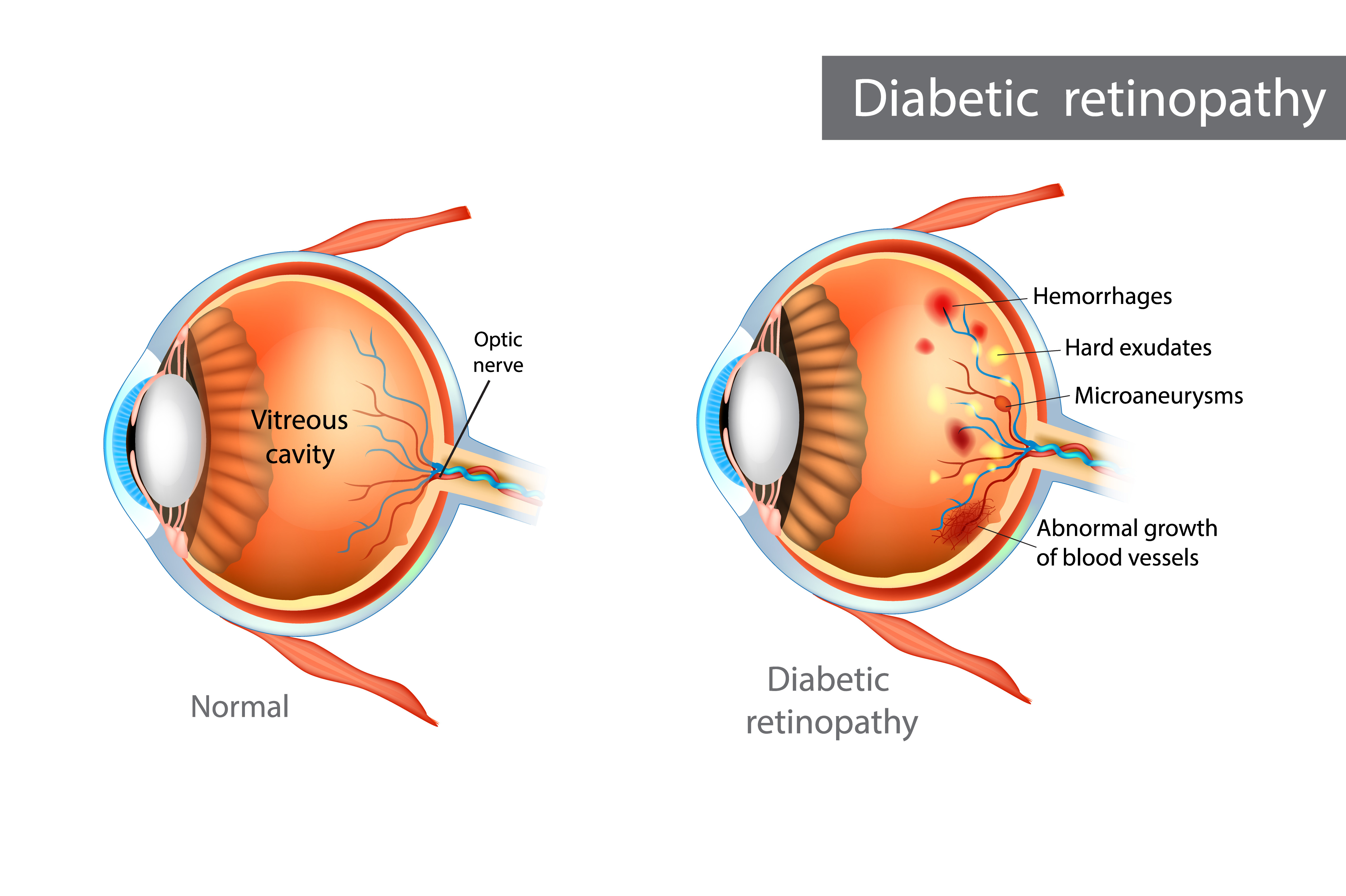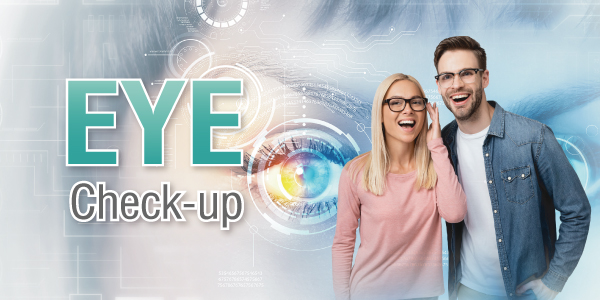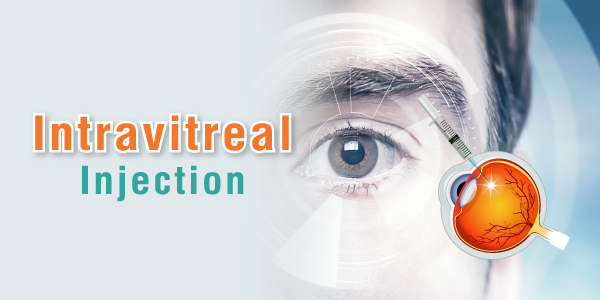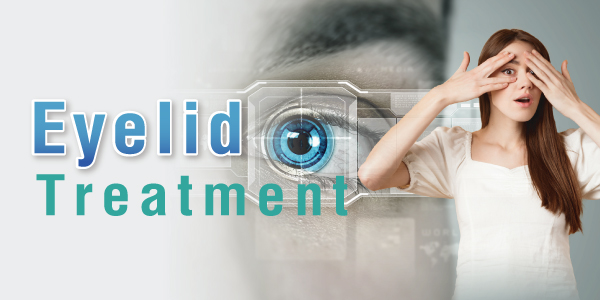Diabetic Retinopathy

Diabetic retinopathy is a complication of diabetes caused by high blood glucose (sugar) levels that damage the blood vessels of the light-sensitive tissue at the back of the eye (retina). However, it generally takes several years to develop and reach a stage where it threatens your sight. At first, there might be no obvious symptoms or only mild vision problems. But it eventually can lead to blindness. The condition can develop in anyone who has type 1 or type 2 diabetes. The longer you have diabetes and the less controlled your blood sugar is, the more likely you are to develop this eye complication.
Symptoms
You might not have symptoms in the early stages of diabetic retinopathy. As the condition progresses, you might develop:
- Spots or dark strings floating in your vision (floaters)
- Blurred vision
- Fluctuating vision
- Dark or empty areas in your vision
- Vision loss
When to see an eye doctor (ophthalmologist)
Careful management of your diabetes is the best way to prevent vision loss. If you have diabetes, see your eye doctor for an annual eye exam with dilation — even if your vision seems perfectly fine.
Developing diabetes when pregnant (gestational diabetes) or having diabetes before becoming pregnant can increase your risk of diabetic retinopathy. If you're pregnant, your eye doctor might recommend additional eye exams throughout your pregnancy. Get in touch with your eye doctor immediately if your vision changes suddenly or becomes blurry, spotty, or hazy.
Causes
Over time, too much sugar in your blood can lead to the blockage of the tiny blood vessels that nourish the retina, cutting off its blood supply. As a result, the eye attempts to grow new blood vessels. However, these new blood vessels don't develop properly and can leak easily.
There are two types of diabetic retinopathy:
- Early diabetic retinopathy.In this more common form — called non-proliferative diabetic retinopathy (NPDR) — new blood vessels aren't growing (proliferating).
When you have non-proliferative diabetic retinopathy (NPDR), the walls of the blood vessels in your retina weaken. Tiny bulges protrude from the walls of the smaller vessels, sometimes leaking fluid and blood into the retina. Larger retinal vessels can begin to dilate and become irregular in diameter as well. NPDR can progress from mild to severe as more blood vessels become blocked.
Sometimes retinal blood vessel damage leads to a buildup of fluid (edema) in the center portion (macula) of the retina. If macular edema decreases vision, treatment is required to prevent permanent vision loss.
- Advanced diabetic retinopathy.Diabetic retinopathy can progress to this more severe type, known as proliferative diabetic retinopathy. In this type, damaged blood vessels close off, causing the growth of new, abnormal blood vessels in the retina. These new blood vessels are fragile and can leak into the clear, jellylike substance that fills the center of your eye (vitreous).
Eventually, scar tissue from the growth of new blood vessels can cause the retina to detach from the back of your eye. If the new blood vessels interfere with the normal flow of fluid out of the eye, pressure can build in the eyeball. This buildup can damage the nerve that carries images from your eye to your brain (optic nerve), resulting in glaucoma.
Diabetic retinopathy
In the early stages of diabetic retinopathy, the walls of the blood vessels in your retina weaken. Tiny bulges protrude from the vessel walls, sometimes leaking or oozing fluid and blood into the retina. Tissues in the retina may swell, producing white spots in the retina. As diabetic retinopathy progresses, new blood vessels may grow and threaten your vision.
Risk factors
Anyone who has diabetes can develop diabetic retinopathy. The risk of developing the eye condition can increase as a result of:
- Having diabetes for a long time
- Poor control of your blood sugar level
- High blood pressure
- High cholesterol
- Pregnancy
- Tobacco use
- Being Black, Hispanic, or Native American
Complications
Diabetic retinopathy involves the growth of abnormal blood vessels in the retina. Complications can lead to serious vision problems:
- Vitreous hemorrhage.The new blood vessels may bleed into the clear, jellylike substance that fills the center of your eye. If the amount of bleeding is small, you might see only a few dark spots (floaters). In more severe cases, blood can fill the vitreous cavity and completely block your vision. Vitreous hemorrhage by itself usually doesn't cause permanent vision loss. The blood often clears from the eye within a few weeks or months. Unless your retina is damaged, your vision will likely return to its previous clarity.
- Retinal detachment.The abnormal blood vessels associated with diabetic retinopathy stimulate the growth of scar tissue, which can pull the retina away from the back of the eye. This can cause spots floating in your vision, flashes of light, or severe vision loss.
- New blood vessels can grow in the front part of your eye (iris) and interfere with the normal flow of fluid out of the eye, causing pressure in the eye to build. This pressure can damage the nerve that carries images from your eye to your brain (optic nerve).
- Diabetic retinopathy, macular edema, glaucoma, or a combination of these conditions can lead to complete vision loss, especially if the conditions are poorly managed.
Prevention
You can't always prevent diabetic retinopathy. However, regular eye exams, good control of your blood sugar and blood pressure, and early intervention for vision problems can help prevent severe vision loss.
If you have diabetes, reduce your risk of getting diabetic retinopathy by doing the following:
- Manage your diabetes.Make healthy eating and physical activity part of your daily routine. Try to get at least 150 minutes of moderate aerobic activity, such as walking, each week. Take oral diabetes medications or insulin as directed.
- Monitor your blood sugar level.You might need to check and record your blood sugar level several times a day — or more frequently if you're ill or under stress. Ask your doctor how often you need to test your blood sugar.
- Ask your doctor about a glycosylated hemoglobin test.The glycosylated hemoglobin test, or hemoglobin A1C test, reflects your average blood sugar level for the two- to three-month period before the test. For most people with diabetes, the A1C goal is to be under 7%.
- Keep your blood pressure and cholesterol under control.Eating healthy foods, exercising regularly, and losing excess weight can help. Sometimes medication is needed, too.
- If you smoke or use other types of tobacco, ask your doctor to help you quit.Smoking increases your risk of various diabetes complications, including diabetic retinopathy.
- Pay attention to vision changes.Contact your eye doctor immediately if your vision suddenly changes or becomes blurry, spotty, or hazy.
Remember, diabetes doesn't necessarily lead to vision loss. Taking an active role in diabetes management can go a long way toward preventing complications.
Heart of Care, Essential Care for You




